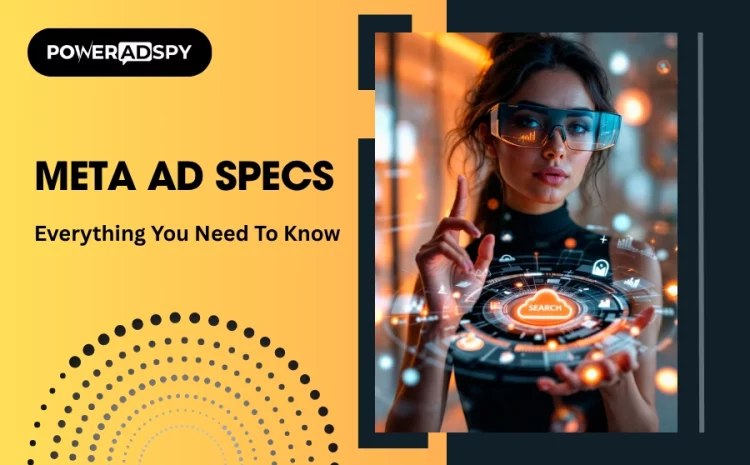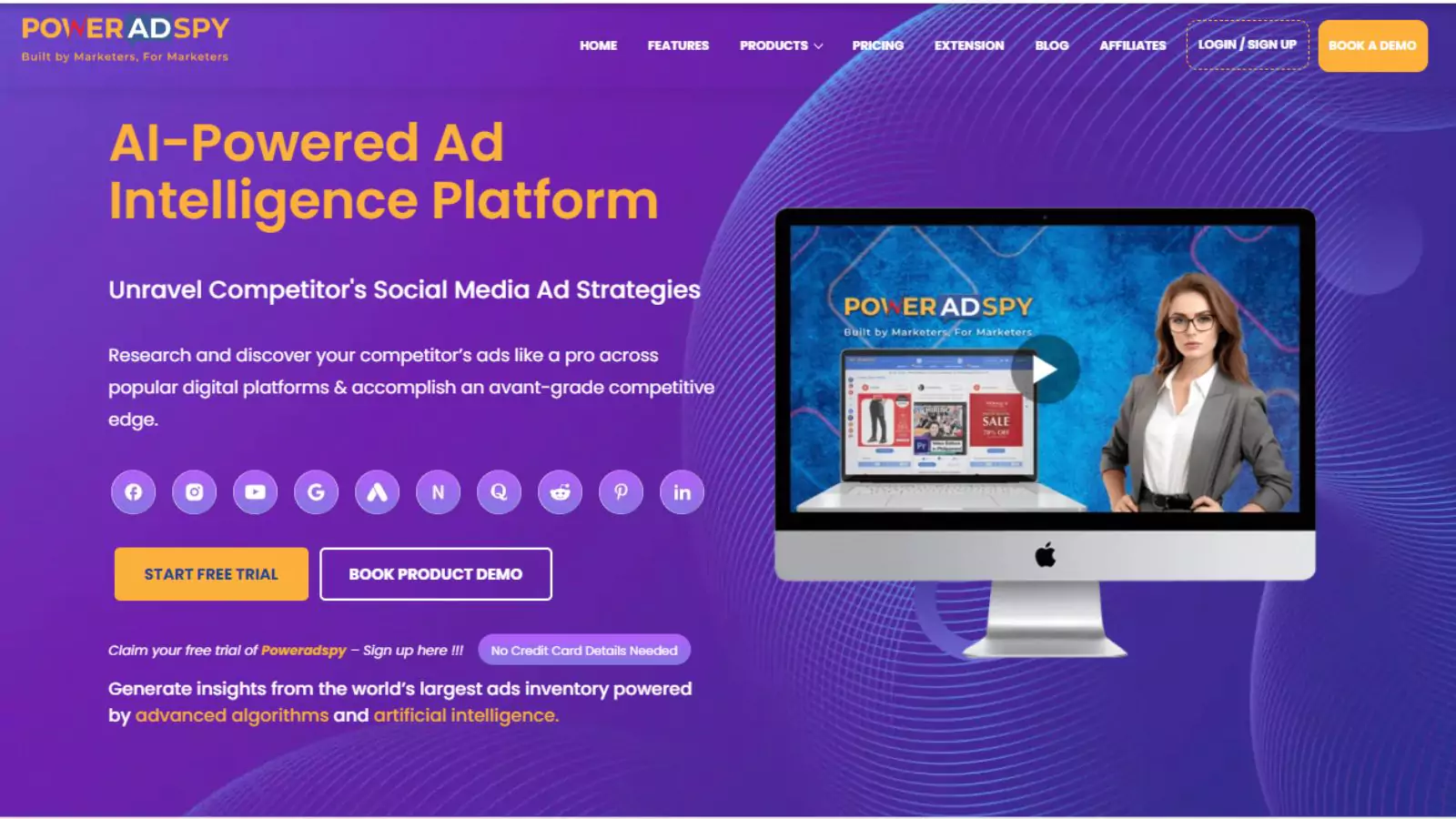Meta Ad Specs: Everything You Need To Know
Digital advertising is moving fast, and staying on top of the latest trends is more important than ever. For marketers using Meta platforms like Facebook, Instagram, Messenger, and the Audience Network, getting your meta ad specs right can make a big difference in how well your campaigns perform. From image sizes and text limits to choosing the right placement, every detail counts.
In this guide, we’ll walk you through everything you need to know about Meta ad specs, explaining the formats, sharing common pitfalls to avoid, offering tips to get better results, and even showing you how to keep an eye on what your competitors are doing.
In a hurry? Listen to the blog instead!
Why Understanding Meta Ad Specs Matters In 2025?
As Meta continues to innovate with new ad formats and placements, keeping up with the latest ad specs isn’t just a box to check it’s key to making sure your ads work. When your content is aligned with current specs, you set your campaigns up for better reach, better performance, and fewer headaches.
1. Maximize Reach
Ads that meet platform guidelines are prioritized for delivery. When your ad fits perfectly within Meta’s preferred specs, it’s more likely to be shown to the right people at the right time. It’s not just about being seen, it’s about being seen first and in a crowded feed, that visibility gives you a serious edge.
2. Better User Experience
Proper specs help create a seamless experience across devices. Nothing disrupts user engagement like stretched images or chopped-off text. By sticking to the correct formats, your content looks polished and professional on every screen. That smooth and consistent look helps build trust and keeps people paying attention.
3. Avoids Rejection
Ads that don’t comply with facebook ads specifications may be disapproved. It’s frustrating to pour time into a campaign only to have it blocked for a small formatting mistake. Meeting ad specs from the start helps you launch faster with fewer revisions. Plus, fewer rejections mean a more reliable campaign timeline.
4. Higher ROI
Optimized ads perform better, leading to better results for your ad spend. When your visuals, copy, and format are all in sync, you’ll likely see better click-through rates and conversions. Think of it as getting more mileage from every ad dollar. The better the fit, the better the results. In short, if you’re advertising on Meta platforms in 2025, knowing the Meta ad specs is no longer optional; it’s essential.
Also read :
How To Use Meta Ad Library The Right Way In 2025?
How To Make Facebook Ads That Convert?
What Is The Overview Of Meta Ad Specs By Format?

1. Image Ads
Image ads are a staple on Meta platforms simple, eye-catching, and effective. Whether you’re promoting a product or building brand awareness, strong visuals can stop the scroll.
Recommended Specs:
- File type: JPG or PNG
- Aspect ratio: 1:1 or 1.91:1
- Resolution: At least 1080 x 1080 pixels
- Text: Keep overlay text minimal
Crisp, high-resolution images help your ad look professional across all devices. And when you keep text to a minimum, your message becomes easier to absorb at a glance.
2. Video Ads
Video is still king in 2025, and the right format ensures smooth playback, faster loading, and better viewer engagement across platforms.
Design Recommendations:
- File types: MP4, MOV, or GIF
- Recommended ratios:
1:1 (great for both desktop and mobile)
4:5 (ideal for mobile) - Resolution:
1:1: 1440 x 1440 pixels
4:5: 1440 x 1800 pixels - Compression settings: H.264 video, square pixels, fixed frame rate, progressive scan, stereo AAC audio (128 kbps+)
- Thumbnails: Sourced from the thumbnail you select during ad creation
Text Recommendations:
- Primary Text: 50–150 characters
- Headline: 27 characters
Technical Requirements:
- Video duration: 1 second to 241 minutes
- Max file size: 4 GB
- Minimum dimensions: 120 x 120 pixels
- Captions and sound: Optional, but both are highly recommended for accessibility and engagement
- Note: Avoid using edit lists or special boxes in your file container
Tip:
Short, captioned videos (under 15 seconds) often get the best engagement, especially on mobile.
3. Carousel Ads
Carousel ads are ideal for storytelling, step-by-step product showcases, or highlighting multiple features in a single format.
Specs:
- File types: JPG, PNG, MP4, MOV
- Image/video size: 1080 x 1080 pixels
- Max cards: 10
- Primary Text: Up to 125 characters
- Headline: Up to 40 characters
- Link Description: Up to 20 characters
Each card works like a mini-ad, pulling viewers through your content in a natural, engaging way. Stick to the specs to ensure a polished, cohesive look across devices.
4. Story Ads
Stories are full-screen, fast-paced, and designed for mobile-first impact. Use them to deliver bold, immersive content that connects instantly.
Specs:
- Aspect ratio: 9:16 (full-screen vertical)
- Resolution: 1080 x 1920 pixels
- File types: JPG, PNG, MP4, MOV
- Max length: 15 seconds per card
- Text: Minimal is best, keep it sharp and impactful
Tip:
Stories should feel native, not disruptive. Design with the vertical layout in mind to take full advantage of the format.
5. Ad Copy Specs (All Formats)
Your ad copy needs to work across placements, so clarity and brevity are key.
Updated Copy Specs:
- Primary Text: 50–150 characters
- Headline: 27 characters
- Description (if used): 30 characters
- CTA Button: Choose from Meta’s standard options
Clear, concise copy prevents truncation and ensures your message comes through loud and clear, whether users are on mobile, desktop, or tablet.
Bonus: 360° Video Ads
Meta also supports 360 videos for some campaign objectives. These interactive formats allow users to explore content by rotating their phone or dragging their finger across the screen—perfect for travel, experiences, and immersive brand storytelling.
What Are The Common Mistakes When Ignoring Meta Ad Specs?
Most beginner marketers don’t have ideas regarding meta ad specs and meta ad library . And when they start their first campaign, it often fails, or it may even get rejected. In such a case, using ad intelligence tools may help you discover competitors’ ads. From there, you can learn about their success and campaign strategies.
Even with powerful tools like PowerAdSpy, which help you analyze and draw inspiration from top-performing ads, success still depends on how well your ads are executed. One of the biggest slip-ups? Overlooking Meta’s ad specs.
Marketers often ignore these crucial details, leading to:
- Ad disapproval: Due to non-compliant content
- Poor engagement: Blurry visuals or cropped text
- Wasted budget: Low-quality ads lead to low performance
- Ineffective targeting: Misalignment between format and audience behavior
Avoid these pitfalls by integrating Meta ad specs into every stage of your campaign planning. When you pair great design with the correct Meta ad specs, you’re setting up your campaign for success.
Try Now
Why Use A Facebook Ad Spy Tool Like PowerAdSpy?
If you want to outperform them on platforms like Facebook and Instagram, you need to understand what strategies they’re using, which creatives are getting results, and how audiences are reacting. This is exactly where a Facebook Ad Spy tool like PowerAdSpy comes in.
More than just a spying tool, PowerAdSpy is your all-in-one ad intelligence platform. It gives you deep, actionable insights into your competitors’ ad campaigns, allowing you to optimize your ads with more clarity and precision. With PowerAdSpy, you can:
1. Explore Ads by Placement
Not all ad placements perform equally. PowerAdSpy allows you to filter ads based on where they appear, whether it’s the News Feed, Side Column, or In-stream, so you can see what works best in your niche. This makes it easier to craft high-converting creatives tailored to Meta’s placement specs and user behavior.
2. Get Real-Time Ad Visibility
Instead of relying solely on reports or screenshots, PowerAdSpy lets you view live ads directly from the platform. This means you can cross-check real-time engagement, read actual user comments, and better understand audience sentiment. It’s transparency that helps you make smarter decisions.
3. Access Over 1 Billion Ads From Over 100+ Countries
With a constantly expanding global database, PowerAdSpy offers access to millions of ads from more than 100 countries. Whether you’re running local campaigns or targeting international markets, you can explore top-performing creatives that align with Meta’s latest ad formats and best practices.
4. Drill Down with Advanced Search Filters
Looking for inspiration in a specific industry? Want to check out what your competitors are doing? PowerAdSpy’s advanced search lets you filter by keywords, advertisers, domains, and even specific formats like video or carousel. You can also visit competitor profiles and see nearly all the ads they’ve been running.
5. Save and Organize Top Ads
As you explore, you’ll likely find standout ads that align perfectly with your goals. With just one click, you can bookmark your favorites into a personal library, no more wasting time trying to rediscover something you saw days ago. This makes campaign planning much smoother.
6. Discover What Works
Thanks to its engagement-oriented details, PowerAdSpy doesn’t just show you ads; it reveals how well they’re performing. You can sort ads by likes, comments, and shares to identify top creatives, helping you learn what truly resonates with audiences and why.
7. Analyze Both Image and Video Ads
While image ads are still relevant, video is dominating social platforms, and PowerAdSpy keeps you ahead of the curve. It features a fast-growing collection of high-performing video ads, giving you insights into creative structure, duration, messaging, and formatting. You can even download them for closer review or inspiration.
How To Use Meta Ad Specs In Your Workflow?
Incorporating Meta ad specs into your workflow helps maintain consistency and quality. It’s not just about following rules, it’s about setting your team up for smoother execution and stronger results. Here’s how you can make ad specs part of your day-to-day process:
1. Creative Briefs: Include the right specs for each format and placement
Clearly outlining specs from the start saves time and reduces back-and-forth later on.
When everyone knows the exact dimensions and limits, creatives can focus on strategy instead of fixing errors.
It also sets the tone for a professional, organized project from day one.
2. Design Templates: Use pre-sized templates to speed up production
Templates eliminate guesswork and help designers create high-quality visuals faster.
With dimensions already in place, there’s more time to focus on creativity and messaging.
Plus, it helps ensure visual consistency across multiple campaigns and formats.
3. Checklists: Before uploading ads, run through a spec compliance checklist
A quick checklist can save you from costly rejections or last-minute edits.
It’s a simple habit that helps keep your campaigns on schedule and stress-free.
Think of it as your final quality check before going live.
4. A/B Testing: Compare performance across formats using proper Meta ad specs
Testing works best when each variant is set up correctly from the start.
Using the right specs ensures that any differences in performance come from the creative, not formatting issues.
It gives you cleaner data and clearer insights for future decisions.
5. Collaboration: Share spec details with designers, writers, and media buyers
Getting everyone on the same page helps avoid confusion and wasted time.
When specs are shared early, each team member can do their part more efficiently.
It fosters a smoother workflow and results in better campaigns overall.
Making Meta ad specs part of your SOPs ensures efficiency and consistency across campaigns.
What Is The Future of Meta Ad Specs?

As advertising becomes more immersive with AR, VR, and AI-generated content, Meta ad specs will continue to evolve, paving the way for richer, more dynamic user experiences. These changes aren’t just technical updates; they’re opportunities to connect with your audience in entirely new ways.
1. Interactive Ad Specs: For AR/VR and 3D experiences
Expect to see ad specs tailored to virtual and augmented reality formats as these technologies gain traction.
This could mean designing 3D assets that respond to user gestures or environments.
Brands that embrace these formats early will stand out by offering a deeper, more engaging brand experience.
2. Personalized Format Requirements: Based on user behavior and preferences
Ad formats may soon adjust in real time based on who’s watching, what they like, and how they interact.
This goes beyond just targeting, it’s about delivering content that adapts to each viewer’s context.
The more tailored your creative, the more relevant and impactful it becomes.
3. Real-time Creative Guidelines: Powered by AI
AI will likely inform how creatives are built and optimized in real-time, suggesting layout, text length, and even tone.
Imagine ad specs that shift dynamically depending on campaign performance or user feedback.
With AI in the mix, marketers can test, learn, and adapt faster than ever before.
4. Dynamic Layouts: For performance-based adaptation
Future layouts may automatically adjust based on screen size, user engagement, or device type.
This means no more one-size-fits-all creatives; your ads will morph to fit the moment.
That kind of flexibility can drastically improve performance across placements.
Conclusion
Understanding and implementing Meta ad specs is not just about technical compliance, it’s about maximizing the impact of every ad dollar spent. With platforms like Meta prioritizing user experience and ad quality, having the right specs for every ad format ensures your campaigns deliver results.
From video to carousel, stories to text, aligning your creative with the latest Meta ad specs puts your brand in the best position to succeed in 2025 and beyond. Combine this with tools like a Facebook Ad Spy Tool and best practices in creative design, and you have a winning strategy for Meta advertising.
FAQs
- What happens if I don’t follow Meta ad specs?
Ans: Ignoring Meta ad specs can lead to ad rejection or poor display, ultimately affecting visibility, user engagement, and overall campaign performance.
- Are Meta ad specs the same for all platforms, like Instagram and Messenger?
Ans: No, each Meta platform has slightly different ad specs. While some overlap, it’s best to tailor your creatives to each platform’s specific requirements.
- How often do Meta ad specs change?
Ans: Meta ad specs are updated several times a year. It’s important to regularly check official sources to ensure your ads meet current standards.
- What tools can help me follow Meta ad specs?
Ans: Design tools like Canva and Adobe, along with Meta Ads Manager and Facebook Ad Spy tools, help you create and monitor ad creatives that meet current specs.
- Can I use one image or video across all placements?
Ans: You can, but customizing creatives for each placement ensures better alignment with specs, improving visual appeal and overall ad performance.
- Do Meta ad specs impact cost per click (CPC)?
Ans: Yes. Ads that meet Meta’s specs tend to perform better, receive higher relevance scores, and can result in lower CPC and more efficient ad spend. - Where can I find the current Meta ad specs?
Ans: The Meta Business Help Center provides the most accurate, up-to-date information on ad specs across all Meta platforms and placements. You can also browse Meta ad examples to see how top-performing campaigns are structured.










